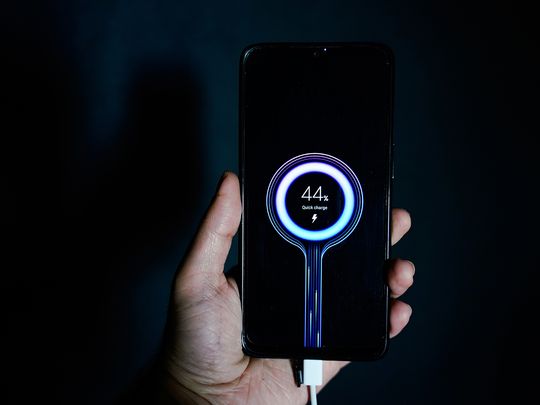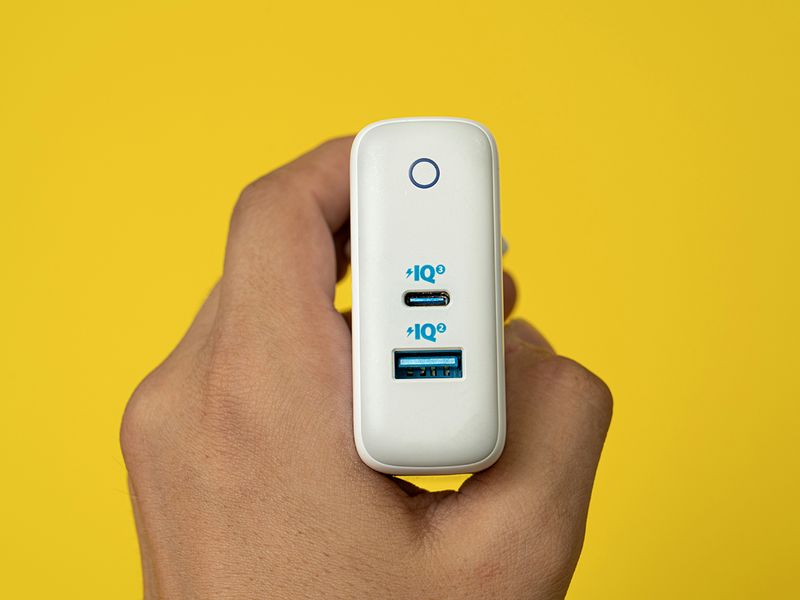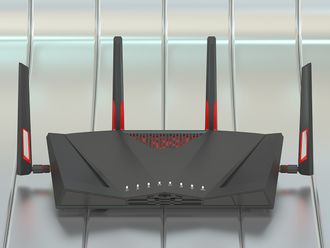
When you purchase a new smartphone, you might notice something unusual: the box is missing a charger.
These days, companies like Samsung and Apple are deliberately excluding USB phone chargers when they sell smartphones, in an attempt to curb e-waste. One charging adapter can be used to power multiple devices, after all. So, if you already charge your tablet or laptop with a USB Type-C charger, it is likely to work just as well for your new smartphone.
But since you’re not getting one right out of the box, it’s up to you to carefully consider your options and budget, and buy a charging brick that meets your requirements.
We spoke with Rinky Rajan, product manager at Newcom (@newcommea on Instagram), a Dubai-based IT distribution company. For those who carry multiple gadgets, she advised: “A larger, multi-port charging brick is better than carrying numerous one-port bricks as they typically offer sufficient wattage power and capabilities.”
However, she cautioned that such bricks tend to be heavier, so they’re not ideal for travel. She added: “Many of these multi-port chargers do not offer the maximum charging power for larger devices, so for someone who wishes to charge their laptop with 150W power, it might be better to keep a separate laptop charger with them.”
In the market right now, there exist 18W (and under) chargers that are primarily designed for smartphones. Then, there are 20W to 30W chargers that are suitable for tablets, and 65W (or higher) chargers that can handle thin or light laptops. There are also chargers with an output of 100W or more, which can handle simultaneous charging for multiple gadgets, even high-performance laptops.
So, do you need a fast charger just for your phone, or would you use it to recharge your tablet and laptop, as well? Do you need a charging brick with many ports? Or a first-party phone charger (like the one supported by OnePlus phones), which would be much faster than standard USB power delivery?
No matter what kind of charging brick you’re looking for, our expert advised us on the best picks for you. Scroll down to read her advice. We’ve curated a list of the best options out there, right now, based on her recommendations, as well as top ratings and user reviews. Pick the one you need, with Amazon Prime and juice up all your devices as early as tomorrow.
1. Best Overall: Targus PowerElite 100W GaN Charger
Pros
- Charge up to four devices simultaneously
- GaN technology
- Comes with international plugs
- Folding prongs for portability
Cons
- Heavy
Rajan’s top recommendation is Targus’ PowerElite, for three reasons: “It is compact, compatible with various international plug standards, and features multiple fast-charging ports.” With two USB-C and two USB-A ports, it offers flexibility, so you don’t have to carry separate USB chargers. You can power up to four devices at once, from smartphones to laptops. The charger comes with interchangeable global plugs (UK, Europe and Asia, Australia, and the US), making it ideal for those who work on the go or frequently travel internationally. All ports are capable of fast charging. Rajan explained how Gallium nitride (GaN) impacts the charger’s performance: “[It] makes it more portable and compact than a silicone counterpart with the same charging capabilities. Replacing silicone with GaN also means that the charger preserves its lifetime (by generating less heat) and draws less power from the outlet.” Some reviewers comment, however, that the bulky plug sometimes falls out of wall sockets.
2. Best Value: Anker 735 Charger
Pros
- Charges up to three devices at a time
- Portable and compact
- USB-C and USB-A compatibility
Cons
- Can break if dropped, reviewers say
Our next-best pick is Anker 735, which is a 65W charging brick that powers up to three devices at once. With two USB-C ports for laptops and tablets, and a USB-A port for a smartphone or smartwatch, it’s a good size for the average user who would like to power up all essential devices in one go. Reviewers attest to it offering excellent value for money, since it’s light, compact, and compatible with most devices. When you connect one device, it focuses all its 65W Max power into juicing it up as quickly as possible. And when you add more devices, it uses PowerIQ 4.0 technology to detect and distribute power based on the needs of the connected device. Anker also uses GaN technology to deliver faster, more efficient charging speeds than standard power bricks, despite the charger’s compact size. Do note that some reviewers caution its prongs can bend or break if it falls, so be careful when plugging it into the socket.
3. Best 30W Charger: Belkin 30W USB-C Wall Charger
Pros
- Fast power delivery
- Compatible with Apple and Android devices
- Comes with a USB-C cable
- Compact and light
Cons
- Charger may block socket below it
If you’re looking for a solo charger for your smartphone or tablet, consider Belkin’s single-device charger. Compatible with both Apple and Android devices, it can boost the power of an iPhone 13 or Galaxy S22 Ultra from zero to 50 per cent in just 24 minutes. Its dynamic power delivery technology delivers up to 25W for Samsung phones, and up to 27W for iPhone 14 Pros, which is why it’s a reliable, speedy charging brick to have on hand when your device is running low on battery. The brick comes with a USB-C to USB-C cable, so you can charge your phones (or laptops, or tablets) immediately. Do note that while it’s as small as a key, the charging port is at the bottom of the brick, and may block any sockets below it.
4. Best 45W Charger: Belkin Boost Charge Pro Dual USB-C 45W Wall Charger
Pros
- Two-port simultaneous charging
- Fast power delivery
- GaN technology
- Rounded shape, no sharp edges
Cons
- Does not include cable
Another fantastic option from Belkin, this dual USB-C charger offers two USB-C ports with a combined maximum output of 45W. This means you can fast-charge two small devices at once, like an iPhone and a Samsung Galaxy phone, or fast-charge one larger device, like an iPad Pro. The Boost Charge Pro can bring up a Samsung S21+ from zero to 50 per cent in just 27 minutes, and an iPhone 13 to the same point in 28 minutes. The brick uses GaN technology for a safe and efficient process that won’t leave your phone feeling overheated or overcharged. The charger does not include any cables, however, so you’ll have to purchase them separately.
5. Best 65W Charger: UGREEN Nexode 65W USB-C Charger
Pros
- Three-port simultaneous charging
- GaN technology for increased efficiency and safety
- Compact and portable
- Foldable design
Cons
- No cables included
Like our top Anker pick, this UGREEN 65W charger is equipped with two USB-C ports and one USB-A port, allowing you to charge three devices simultaneously. With its PD 3.1 protocol, a single port can pump 65W of power to a MacBook Pro 16-inch laptop, charging it fully in just 1.5 hours. It’s compatible with most brands of smartphones, laptops, tablets and smartwatches, giving you the flexibility and convenience of charging them all with a single brick. Although no cable is included, the Nexode has other useful features going for it, like a travel friendly, foldable design, and always-on temperature detection that keeps your gadgets safe from overheating. Reviewers say it’s extremely fast – some have juiced up powerbanks with 20,000mAh batteries within two hours. Others say its charging speed remains consistent, even when it’s recharging multiple devices.
6. Best 120W Charger: Anker 737 120W GaN Prime Charger
Pros
- Three-port simultaneous charging
- Compact design
- Fast, efficient power delivery
- Seamlessly charges full-size laptops at high speeds
Cons
- Becomes warm with use
Like our top pick, the Anker 737 supports power delivery for three devices at once – with two USB-C ports and one USB-A port – but it ramps up power to 120W. That’s double the output of Anker 735, and enough to charge a large laptop, along with two other power-hungry devices, like a smartphone and tablet. If you connect a single device, it rapidly charges it at up to 100W. And if you add more gadgets, Anker’s PowerIQ 4.0 technology detects the needs of connected devices and adjusts power delivery automatically for fast, efficient distribution. The brand’s ActiveShield 2.0 intelligently monitors temperature to safeguard connected devices, and the brick is compatible with virtually all electronics, like tablets, notebooks, phones and accessories. Reviewers say it’s reliable and fast, but tends to get warm during extended charging sessions.
Warranty: The manufacturer provides 18-month warranty.
7. Best High-Power Charger: Razer 130W USB-C GaN Charger
Pros
- Four-port simultaneous charging
- GaN technology
- Supports PPS
- Comes with power plug adapter
Cons
- Slightly bulky
If you’re looking for a charger that can rapidly charge your ultraportable laptop, and have juice to spare, consider Razer’s 130W GaN charger. With four ports – two USB-C and two USB-A – the brick can recharge your smartphone, tablet, laptop and gaming headset, all at the same time. Its two USB-C ports support 100W max each (this power is split into two if both ports are in use, which still means incredibly speedy charging). Its Programmable Power Supply (PPS) technology allows it to modify voltage and current, based on the device’s charging status, which means it’s efficient and safe to use. Although the charger is slightly bulky, it’s ready for travel, since it comes with a convenient power plug adapter that fits most power outlets around the world.
Bonus: Buy with zero per cent installments and pay Dh54.33 for 12 months with select banks.
What are some things to consider before buying a charging brick?

Walk down an aisle with fast chargers, and it boggles the mind – there are so many to choose from. So, where do you start?
Rajan shared several aspects to consider before buying a fast-charging brick:
- Power intake: Just how much power intake does your device accommodate? Rajan said: “Ideally, devices capable of fast charging should be charged by compatible power bricks. On the other hand, although devices not capable of fast charging will generally not face damage by receiving more power than they are capable of utilising, it is good to double-check the limits of your device before making a purchase.”
- Utility: What are you using the charger for? If it’s for temporary use, you’ll likely not require a relatively expensive multi-port charger, or one that’s suitable for travel. Depending on what you are using it for, you “would benefit from considering factors such as the number and type of ports supported by a charging brick and its weight and portability”, Rajan advised.
- Travel considerations: Plug compatibility becomes a primary concern when you’re looking for a charger that you can use internationally. Rajan said: “There are multi-port charging bricks that come with interchangeable plugs that meet different international plug standards (namely, UK, US, and Europe), and these may be helpful for individuals who travel internationally frequently enough to require this level of flexibility.”
- Credible brands: Don’t settle, when you’re buying a charger – it may harm your device, if it’s not up to the mark. Rajan said: “Buyers should pay attention to the manufacturer of the charging brick they wish to purchase. Since regulatory testing requirements are more stringent in some countries than others, credible manufacturers that sell products worldwide are more likely to meet the necessary regulatory testing and standards. Although rare, some manufacturers do not meet such standards, which can ultimately damage the charging device, even the user (if it catches fire or emits a shock).”
Minimum wattage guidelines
You would think the greater the power, the faster your device will charge. But a smartphone doesn’t require a 100W multi-port charger, just like a laptop won’t recharge rapidly when it’s charging on a brick that’s below 65W.
To break down the wattage requirements of specific electronics, we asked Rajan for some clarity. Here’s what she said:
Smartwatch: Smartwatches are small, delicate devices compared to phones. So, if a compatible charging wall adapter is unavailable, charge them using a laptop or desktop as the power source.
Smartphone: 10W to 18W is standard wattage for charging a phone (18W or more if the phone supports fast charging). Anything below 10W is not recommended, as charging a smartphone with lower than standard wattage can damage the battery in the long run.
Tablet: 20W to 30W, which ranges between standard and fast-charging. The ideal power in this range will depend on the device’s capabilities, but keep in mind that anything below can take too long to charge the device (between eight to nine hours instead of two to three hours) and result in battery damage in the long run.
Laptop: 65W+ is recommended for laptops, although 100W is much better, and anything above that would be ideal for those with laptops capable of handling more power.
Rajan added: “If someone prefers using a wall outlet, they must ensure that the adapter is UL-certified and offers a power output of five volts or one ampere (or less). Avoid fast chargers for smartwatches as they can damage the watch by delivering surplus power in the long run.”
Our recommendations are independently chosen by Gulf News editors. If you decide to shop through links on our website, we may earn an affiliate commission, as we are part of Amazon Services LLC Associates Program.











